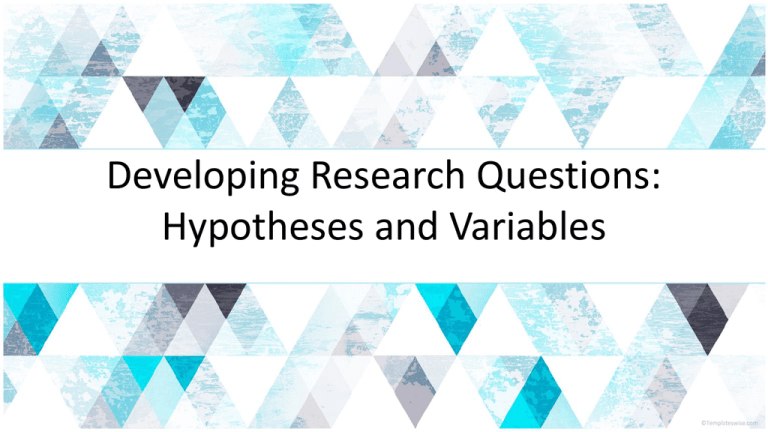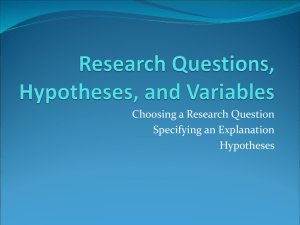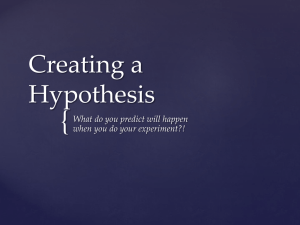NAME OF PRESENTATION
advertisement

Developing Research Questions: Hypotheses and Variables How to come up with a question? • 1. Research questions are developed by using sources that include curiosity, professors, textbooks, • journals, databases, and the Internet. Keywords based on your research topic are used to search the literature for information and prior Research on the topic. Research questions can be designed to evaluate a theory, to compare two or more theories, to address a practical problem, to resolve inconsistencies in the literature, to replicate a prior study, or to investigate a particular question that has not yet been studied. Research questions lead to a hypothesis that states the predicted outcome for the study Good hypotheses have several characteristics, including a clear rationale, an if–then format, and a clear description of the relationship between the variables of interest in the study. Variables • The independent variable (treatment) is the variable that is under the control of and manipulated by • the experimenter. The behaviour that is affected by the treatment and that we measure is called the • dependent variable Qualitative vs. quantitative A qualitative independent variable is one for which the levels represent different and distinct categories. A quantitative independent variable is one for which the levels represent different amount of that variable • • • • Selection of the levels of a quantitative independent variable depends to some degree on the estimated nature of the functional relationship between the independent and dependent variables. A good dependent variable should be objective, quantifiable, reliable, and sufficiently sensitive to changes in the independent variable. The dependent variable should be selected so as to avoid floor effects and ceiling effects—that is, a limited range of values. Dependent variables often measure accuracy, latency, duration, or intensity of responding. In many situations, multiple dependent variables can be recorded to provide more information about the relationship between the independent and dependent variables. Hypothesis • It is an educated guess regarding what should happen in a particular situation under certain conditions. • Not all studies require that you test a hypothesis; some may simply involve collecting information regarding an issue. • Hypotheses should not be based simply on what the student believes should happen. A clear rationale is necessary. Examples: • An examination of publications by student researchers provides several examples of hypotheses. In a study that examined gender equity in college athletic programs, the authors predicted “female students would have more positive attitudes toward gender equity” (Teel, Fuller, & Allen, 1998, p. 20) Employees will be more productive when working under bight lights than when working under dim lights Another example, one student predicted “extroverts were more likely to be hired than introverts because of their outgoing and personable behaviour” (Sheets, 1999, p. 8) A good hypothesis • Good hypotheses have several characteristics, including a clear rationale, an if–then format, and a • clear description of the relationship between the variables of interest in your study Clear Rationale: “Why am I predicting this effect?” It may be that you are replicating a study already reported in the literature. It may be that your prediction is a logical extension of what other researchers have published • • • • • It may be that your prediction follows from a particular theory and 4 - 6 provides a test of the theory. For example, one theory in social psychology states that as the number of bystanders increases near a victim, each bystander feels less responsibility to help the victim. Based on this diffusion of responsibility theory, you might predict that if a student drops her books in a crowded student center on campus, then the student will be less likely to receive help than if only a few people are in the student center. Notice that this hypothesis provides a clear description of the relationship between the first variable (number of bystanders) and the second variable (likelihood of receiving help) and does so using an if–then format. If particular environmental conditions exist, then there will be a particular consequence in terms of human behavior. Functional variables relationship • The dependent variable is always a measure of behaviour that we record after first manipulating the independent variable. It is referred to as dependent because changes in it depend on the effects of the independent variable. • If a systematic relationship is found between the independent and dependent variables, then we have established an empirical or causal relationship. Functional Relation An experimentally determined relation that shows that the dependent variable depends on or is a function of the independent variable and nothing else. A lawful relation between values of two variables. In behaviour analysis, a dependent variable (treated behaviour) and a given independent variable (intervention or treatment procedure) are functionally related if the behaviour changes systematically with changes in the value of the independent variable or treatment. For example, the greater the intensity of an aversive stimulus, the greater the response suppression. 14 Case Analysis A researcher wonders how well the sense of smell functions during sleep. In general, we know that our sensory systems operate at a higher threshold during sleep. That is, a more intense stimulus is required to elicit a response during sleep than during wakefulness. Furthermore, we are less responsive during some stages of sleep than during others. Experiments using sounds suggest that we are less responsive during stages 3 and 4 sleep (deep sleep) than during stages 1, 2, or REM sleep (lighter sleep). Thus, the 4 - 16 researcher predicts that research participants will be less responsive to odours during stages 3 and 4 sleep than during the other stages of sleep. The researcher devises a system for delivering odors while college students sleep in the laboratory. Peppermint fragrance is delivered at specific times through a modified oxygen mask that the students wear while they sleep. Electrodes are attached to each student’s scalp, face, and chin to determine sleep staging. Electrodes are also attached to each student’s chest to record heart rate. A change in heart rate following presentation of the odor is used to indicate that the participant detected the odor. Critical Thinking Questions • • • • 1. What is the research hypothesis? 2. What is the independent variable? 3. What is the dependent variable? 4. From which response class does the dependent variable come? • 5. Is the independent variable a qualitative variable or a quantitative variable? Explain. • 6. Why might the researchers want to use multiple dependent variables? • 7. Describe one limitation of this study. Seeking Solutions Scenerios In pairs, read through the observations below and choose one scenario that interests you. Brainstorm explanations for the observations and use the explanations to form several possible hypotheses. Then develop one or more experiments to test your hypotheses. Scenario 1 • You have often noticed that ants follow one another in a trail to food. How do they know to follow each other in the trail? Do they have a form of communication that we can't hear or see? Or do they follow the trail because they see other ants following the trail? • Make several hypotheses that could explain why ants follow one another in a trail to food. Then design an experiment to test one of your hypotheses. What results would you observe if your hypothesis is true? What results would you observe if your hypothesis is false? Scenario 2 You are at the top of Mt. Haleakala, a dormant volcano that rises over 10,000 feet above the island of Maui in Hawaii. You noticed that a person nearby is talking about starting to feel dizzy, while someone else is complaining about a sudden headache. You feel fine. Why are some people feeling sick when others are not? Is it the air around the volcano? Is it the altitude? Or are the problems completely unrelated to the location? Make several hypotheses that could explain why certain people feel sick at the top of Mt. Haleakala while others do not. Then design an experiment to test one of your hypotheses. What results would you observe if your hypothesis is true? What results would you observe if your hypothesis is false? Interactive exercise Go to this link and attempt (collectively) to answer the MCQs: mailto:http://onlinestatbook.com/2/introductio n/variables.html







